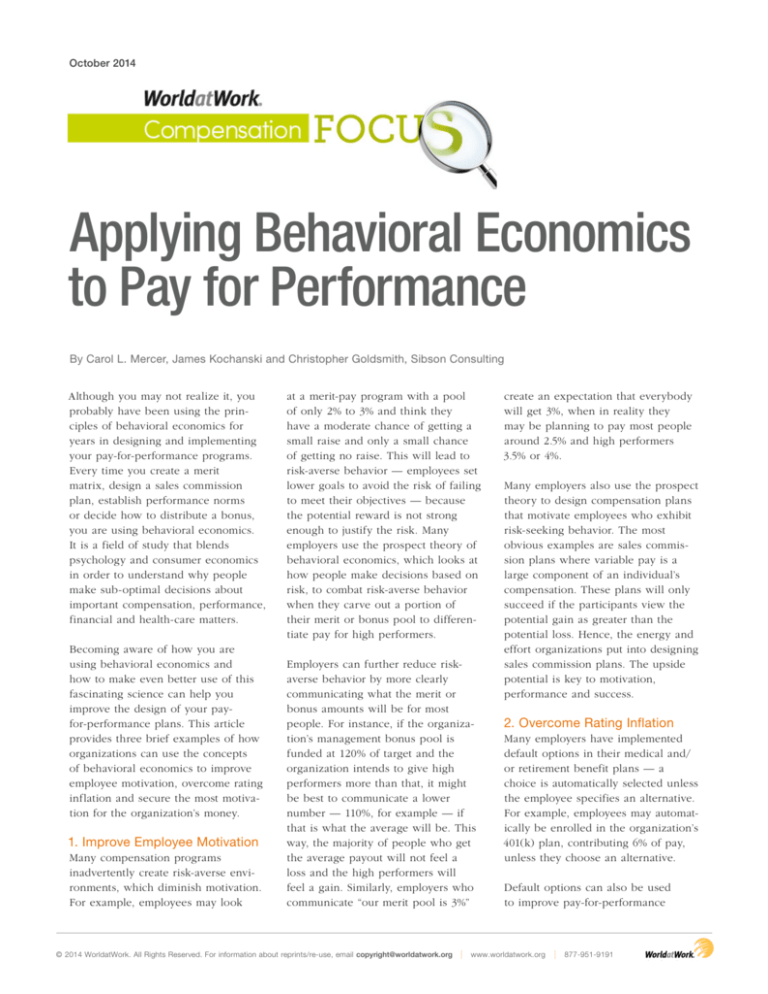
October 2014
Applying Behavioral Economics
to Pay for Performance
By Carol L. Mercer, James Kochanski and Christopher Goldsmith, Sibson Consulting
Although you may not realize it, you
probably have been using the principles of behavioral economics for
years in designing and implementing
your pay-for-performance programs.
Every time you create a merit
matrix, design a sales commission
plan, establish performance norms
or decide how to distribute a bonus,
you are using behavioral economics.
It is a field of study that blends
psychology and consumer economics
in order to understand why people
make sub-optimal decisions about
important compensation, performance,
financial and health-care matters.
Becoming aware of how you are
using behavioral economics and
how to make even better use of this
fascinating science can help you
improve the design of your payfor-performance plans. This article
provides three brief examples of how
organizations can use the concepts
of behavioral economics to improve
employee motivation, overcome rating
inflation and secure the most motivation for the organization’s money.
1. Improve Employee Motivation
Many compensation programs
inadvertently create risk-averse environments, which diminish motivation.
For example, employees may look
at a merit-pay program with a pool
of only 2% to 3% and think they
have a moderate chance of getting a
small raise and only a small chance
of getting no raise. This will lead to
risk-averse behavior — employees set
lower goals to avoid the risk of failing
to meet their objectives — because
the potential reward is not strong
enough to justify the risk. Many
employers use the prospect theory of
behavioral economics, which looks at
how people make decisions based on
risk, to combat risk-averse behavior
when they carve out a portion of
their merit or bonus pool to differentiate pay for high performers.
Employers can further reduce riskaverse behavior by more clearly
communicating what the merit or
bonus amounts will be for most
people. For instance, if the organization’s management bonus pool is
funded at 120% of target and the
organization intends to give high
performers more than that, it might
be best to communicate a lower
number — 110%, for example — if
that is what the average will be. This
way, the majority of people who get
the average payout will not feel a
loss and the high performers will
feel a gain. Similarly, employers who
communicate “our merit pool is 3%”
© 2014 WorldatWork. All Rights Reserved. For information about reprints/re-use, email copyright@worldatwork.org
create an expectation that everybody
will get 3%, when in reality they
may be planning to pay most people
around 2.5% and high performers
3.5% or 4%.
Many employers also use the prospect
theory to design compensation plans
that motivate employees who exhibit
risk-seeking behavior. The most
obvious examples are sales commission plans where variable pay is a
large component of an individual’s
compensation. These plans will only
succeed if the participants view the
potential gain as greater than the
potential loss. Hence, the energy and
effort organizations put into designing
sales commission plans. The upside
potential is key to motivation,
performance and success.
2. Overcome Rating Inflation
Many employers have implemented
default options in their medical and/
or retirement benefit plans — a
choice is automatically selected unless
the employee specifies an alternative.
For example, employees may automatically be enrolled in the organization’s
401(k) plan, contributing 6% of pay,
unless they choose an alternative.
Default options can also be used
to improve pay-for-performance
| www.worldatwork.org
| 877-951-9191
plans. Many organizations have
rating inflation — too many people
receive high ratings — which makes
it hard to differentiate rewards for
high performers. Moreover, some
managers complain that performance
management and pay for performance
are too complicated.
A solution from behavioral economics
is to have “meets expectations” or
average performance as the default
option, and make managers document or justify any above- or
below-average ratings to give
employees merit increases that vary
from the standard. This encourages pay differentiation, which
helps the organization reward and
retain top performers.
3. Get the Most Bang for
Your Motivation Bucks
Conventional thinking suggests that
smaller, more frequent rewards (e.g.,
bonuses) are most effective, but
behavioral economics studies reveal
two counter-balancing effects:
Compensation Focus october 2014
❙❙ Hyperbolic discounting
is a common bias where
most people dramatically
undervalue deferred rewards.
❙❙ Probability neglect is another
common bias — people undervalue low-value rewards with a
high probability of occurring (e.g.,
getting your 10th car wash free)
and overvalue high-value rewards
with a low probability of occurring (e.g., winning the lottery).
Clearly, the size and timing of a
reward makes a big difference. People
are willing to wait for large rewards.
For example, most people eligible for
a $5,000 bonus would rather receive
a check for $5,000 (minus taxes, etc.)
at year-end than have $200 (minus
taxes, etc.) added to their twicemonthly paychecks for the next year.
This is in part because people do not
emotionally connect with the time
value of money or the impact of taxes
when they think about bonuses. By
applying behavioral economics, organizations can get the most motivation
from their investment.
Conclusion
These are but three examples of
how behavioral economics can be
extremely useful in designing and
communicating pay-for-performance
plans. Although you may not recognize it, you are probably already
using behavioral-economics principles to improve how you reward
your employees. Taking a closer
look at behavioral economics will
allow you to use this science to
its full advantage.
About the Authors
Carol L. Mercer is a vice president and senior
compensation consultant with Sibson Consulting
in Phoenix.
Jim Kochanski is a senior vice president and
leader of the Performance and Rewards Practice
with Sibson Consulting in Raleigh, N.C.
Christopher Goldsmith, an expert on
behavioral economics, is a vice president and
senior consultant with Sibson Consulting in
Cleveland.






